-
 2497 Hits
2497 Hits
-
 80.49% Score
80.49% Score
-
 12 Votes
12 Votes
|
|
Route |
|---|---|
|
|
45.76750°N / 7.23933°E |
|
|
Hiking |
|
|
Spring, Summer, Fall, Winter |
|
|
Half a day |
|
|
E (Easy) |
|
|
Note
|
La montagna chiama i suoi figli, ed essi rispondono fedelmente al suo appello… Osvaldo Cardellina, Diario alpinistico, 1964-65 Page texts: @ OsvaldoCardellina "Osva", passed away on May 2, 2022. Page owners: Christian Cardellina e Osvaldo Cardellina. Any updates from September 12, 2022: Antonio Giani, page administrator, friend and climbing companion. Testi della pagina: @ OsvaldoCardellina "Osva", scomparso il 2 maggio 2022. Proprietari pagina: Christian Cardellina e Osvaldo Cardellina. Eventuali aggiornamenti dal 12 settembre 2022: Antonio Giani, amministratore della pagina, amico e compagno di salite. |
White & Gel Overview
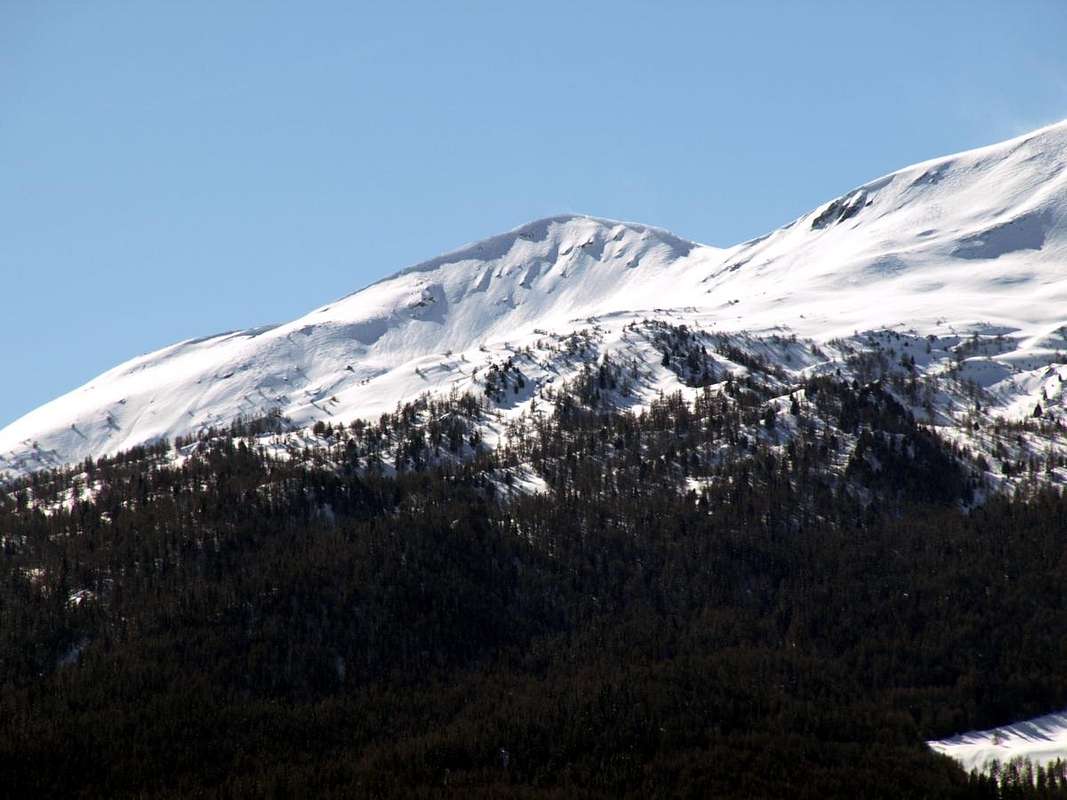
This easy Hiking journey to the Eastern slopes of Mont Fallère (3.061m) into a small Group can be performed in various ways and with different starting points.
In fact it can start from Hill of Aosta and, after reaching the Pointe de Metz (2.553m), across the entire watershed first with the Valley of Clusellaz and then with that of Arsy or Ars, the latter above the Municipality of Etroubles in Valle del Gran San Bernardo. After having climbed the Pointe Chaligne (2.608m), descend to Colle and the Crest or Coast Tardiva (2.410m, 2.418m) from which quickly reach Rifugio Chaligne (1.936m), in the uppermost part of the Torrent Val Buthier in the Municipality of Gignod. The most widely used route, however, especially after the construction of the shelter, consists precisely in the fact to going up and the eventual crossing proper from this side starting at the junction on Highway at the Condemine Fraction. A third approach, but certainly a lot less frequented, is that with the departure by Etroubles then up almost along all the adjacent Valley of Ars or Arsy, at the foot of the wide Northern Slope of Fallère. Three different ways to accomplish the same whereas in the former case the route happens from South to North and possible return through the small saddle 2.126 meters towards Checottayes above Aosta, while the reverse happens in the next two and in this last, you can make some connections between the Vallon of Arsy and Val Buthier. But the factor that differentiates these trips more results from the fact that while the first and last are directed almost exclusively to the Hiking, the middle is almost a requirement for the Ski-Mountaineering; including all highlights the practice by Snowshoeing, always good aid for the presence of deep snow. Can do is arm yourself with good will always paying attention to the danger of snowslides and avalanches, which have already caused some fatal accidents. As a counterpart a Nature still lush and well-preserved and beautiful views from the Aosta City to the Great St. Bernard "flying" above the nearby Val Pelline until the big Dam of Place des Moulins and the Chain from Grandes Murailles to the Dent d'Hérens and Ollomont Valley, which opens like a large fan from first rocky and then glacial Punta Fiorio-Morions Group-Gelé up to mammoth Grand Combin de Grafeneire (4.314m) and the biggest ice dome of Velan (3.798m). Always Fallère allowing ...

Facile attraversata escursionistica alle pendici Orientali del Gruppo Mont Fallère (3.061 m) che può essere effettuata in vari modi e con diversi punti di partenza.Infatti si può partire dalla Collina di Aosta e, dopo avere raggiunto la Pointe de Metz (2.553 m), attraversare tutto lo spartiacque dapprima con il Vallone di Clusellaz e quindi con quello di Arsy od Ars, questo ultimo al di sopra del Comune di Etroubles nella Valle del Gran San Bernardo. Dopo aver scavalcato la Pointe Chaligne (2.608 m), si scende al Colle ed alla Cresta Tardiva (2.410 m, 2.418 m) dalla quale in breve tempo si raggiunge il Rifugio Chaligne (1.936 m), collocato nella parte più elevata del Torrent Val Buthier nel Comune di Gignod. Il percorso più utilizzato però, soprattutto dopo la costruzione del rifugio, consiste proprio nel fatto d'effettuare la salita e l'eventuale traversata proprio da questo versante con partenza al bivio sulla Strada Statale presso la Frazione di Condemine. Un terzo approccio, ma sicuramente molto meno frequentato, risulta quello con partenza da Etroubles risalendo poi quasi tutto l'adiacente Vallone d'Ars od Arsy, posto ai piedi del largo Verante Settentrionale del Fallère. Tre modalità differenti per compiere la medesima considerando che nel primo caso la stessa avviene da Sud a Nord e con eventuale rientro tramite la piccola sella 2.126 metri verso Checottayes sopra Aosta, mentre nei successivi due avviene l'inverso ed in questo ultimo si possono effettuare alcuni collegamenti tra il Vallone di Arsy e la Val Buthier. Ma il fattore che diversifica maggiormente queste gite risulta dal fatto che, mentre la prima e l'ultima sono rivolte quasi esclusivamente all'Escursionismo, quella intermedia é quasi di obbligo per lo Sci-Alpinismo; tra tutte si evidenzia la pratica delle Racchette da neve, sempre di ottimo ausilio in presenza di neve alta. Non rimane che armarsi di buona volontà facendo sempre attenzione al pericolo delle slavine e delle valanghe, che qui han già provocato alcuni incidenti mortali. Come controparte una splendida Natura ancora rigogliosa e completamente ben conservata, nonché splendide vedute dalla sottostante Città d'Aosta fino al Gran San Bernardo "volando" al di sopra delle vicine Valpelline fino alla grande Diga di Place des Moulins ed alla Catena Grandes Murailles-Dent d'Hérens e di Ollomont, che qui si apre a guisa di grande ventaglio dapprima roccioso e poi glaciale dalla Punta Fiorio-Gruppo dei Morions-Mont Gelé fino al mastodontico Grand Combin de Grafeneire (4.314 m) ed alla grande cupola ghiacciata del Mont Velan (3.798 m). Sempre Fallère permettendo ...

Getting There
BY CAR:
- From TORINO, MILANO, etc: Motorway A5. Exit at IVREA or Quincinetto (PIEDMONT),
- From IVREA: in West towards Pont St. Martin, Donnas, Bard, St. Vincent, Chatillon, Nus, Quart, St. Christophe, Aosta Sarre (in West) or Gignod (North) Municipalities.
From Courmayeur Resort: in East to Pré St. Didier, Morgex, La Salle, Saint Pierre, Villeneuve, Sarre, Aosta or in North to Gignod Municipalities. - From Sarre Common to Aosta City and by this towards Gignod Municipality in Great St. Bernard Valley
From Sarre (657m), with Regional Road, towards Plèod, Vert Dessous and Dessus, Vareille, Caillod/Ville sur Sarre/Remondet, Moulin/la Cort, forks (1.225, 1.301) meters, Salet, Chavalançon (1.426m) small Villages to Thouraz Dessous and Dessus Hamlets (1.652m); from the last to wide Met Basin.
From Aosta North Town with Main Route towards Gignod Commune (988m) with Great St. Bernard SS.27 to alternative nearby Condemine Hamlet (1.137m); leaving left through Municipal Road to Grand e Petit Buthier Villages (1.302m, 1.439m) in Chaligne Comba. From this last, with private dirt farms roads and through Mendey, Roncaille, Rombason Pastures up to the Chaligne Shelter (1.936m), below Costa Tardiva (2.380m), Tardiva Hill (2.410m) and neighboring of Punta Chaligne (2.608m), Col and Pointe de Met (2.492m, 2.553m).
From Etroubles Commune (1.270m), with dirt road and through Champ-Reclos (1.425m), Yettes (1.591m), Eteley (1.716m), fork before Praz-Gallet (1.626m), Ars (1.975m) Pastures on Arsy Vallon, up to Chaz d'Arsy (2.543mn); from this paths to Tardiva Pass (2.410m) and Costa Tardiva (2.418m, 2.394m). - From FRANCE: through the Mont Blanc Tunnel to Entrèves-crossroads to Vény/Ferret Valleys - Mountain Guides of Courmayeur - La Saxe Rock Gym - Courmayeur. By Little Saint Bernard Pass, closed since November until half May to La Thuile Valley - Pré Saint Didier - Courmayeur.
It is not necessary to take Motorway A5: you can drive on SS.26, in the direction of AOSTA - IVREA - TURIN.
BY PLANE:
- Aeroporto "Corrado Gex" Saint Christophe (Aosta).
Routes Description

A) - Approaches from Thouraz Hamlet through the locality called "la Tsitra" or by the Comba de Labe or Clou small Vallon:
1) - Arpilles small Valley: from Aosta Town Northern sector with Main Route of Valley Great Saint Bernard Valley to alternative nearby Grand Signayes Hamlet (737m); through the deviation, always in asphalt, to Arpuilles (1.010m) and Excenex (1.046m) Fractions. From these by farm dirt roads or various paths numbered or not, to Tsa de Metz or "Les Arpes Vieilles" (1.419m), above Checotteyes (1.715m) Alpage. From this point to Met Hill with the path n° 3 then by Northern Crest through a small trace n° 7B.
2) - Clou-Met(z)-Chaligne small Valleys always through Met Pass and Northern Crest: from Touraz new Hamlet (1.593/1.652m; Horses Ranch; no transit signal immediately after) in East-northeast through private dirt farms road concomitant with the path n° 6 towards Metz Bionaz (1.731m), Vignon (1.789m), Condemine de Metz (1.874m) Pastures and Metz Alp (2.261m), nearby Labe Torrent. From Alpage always with the trail n°6 towards Met Hill, between Chaligne Met Summits, and preceding route.
3) - By Thouraz Dessus through the route towards "la Tsitra" and along the Southern Crest:
a1) - with larger circle first Eastward with the farm road and past Vignon, Condemine de Metz and Moulin Pastures (1.794m, 1.876m, 1.880m), to the town named "Berrio Bat" (1.954m) in the Bois de Ban and then to the West you reach the hairpin 2.140 meters, just below "the Tsitra" and quickly with small crossing to the West the Southern Crest.
a2) - or from the hairpin bend continue towards the North through the same, concomitant to route n° 8C, coming to Tsa de Met whence the Hill and the Pointe de Met.
Note: these two itineraries are the most advisable route in the forest when there is too much snow covering the trail; agrees therefore a turn wider but also more open and identifiable reference points, as well as more exposed to the sun before that transforms it. In the second, however, we have to be more attentive to the overlying slopes East, as well as the ascent of the hill. In any case in the presence of high snow you have to be absolutely far from the same, climbing only the two ridges, of which the better the Southern. Of note in fact the advent of fairly recent for avalanche fatalities in the slopes of Pointa Chaligne (especially the East-northeast Slope above Alp and Refuge Chaligne).
Variant a) - from Moulin fording towards the small West Torrent de Conclonaz through the path not numbered nor reported meet the quota in 2008 between the Bois de Thouraz and Montagnetta; from here with the trail n° 7B to the Summit.
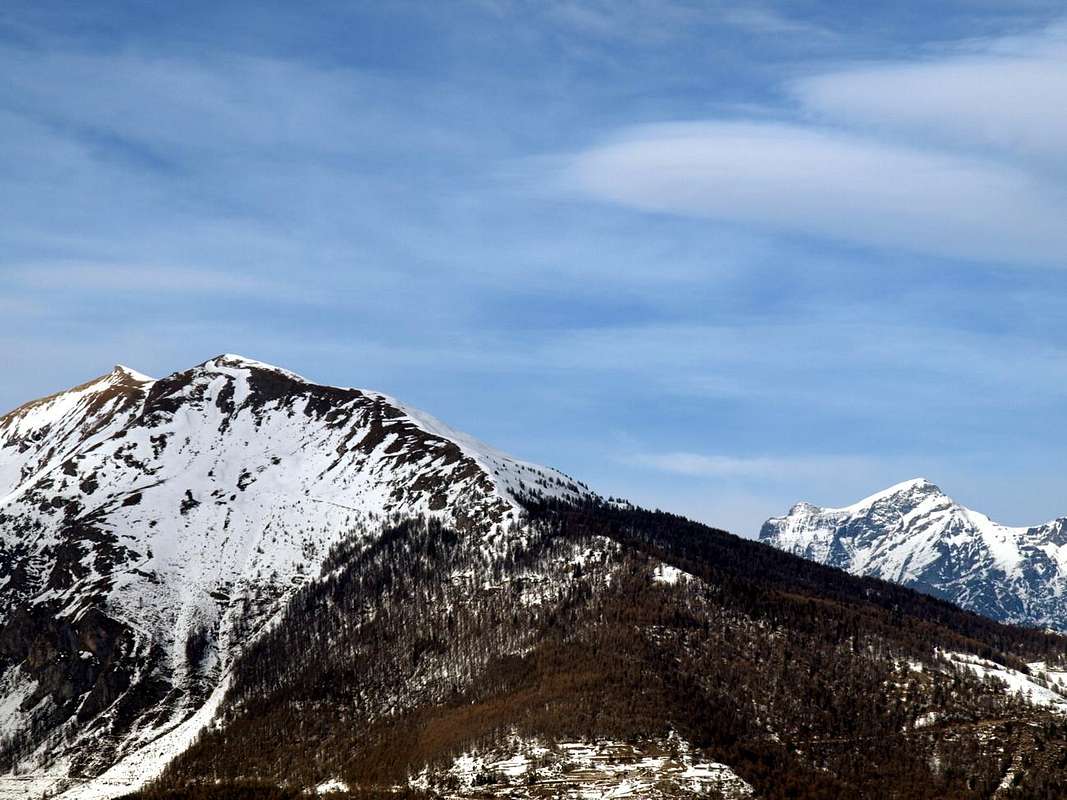
B) - Approach Aosta towards Great St. Bernard by State Road n°27 and alternative near Condemine Hamlet through variants with possibilities by Snowshoes:
4) - from Condemine alternative on State Road towards the above Villages of Grand Buthier (1.302m), Petit Buthier (1.439m) and Roncailles, Rombason, Crossroads 1.854 meters through the path n° 3A/2A or concomitant with the dirt road, always n° 3A/2A and subsequent crossing from fork 2.150 meters on watershed North/South of Costa Tardiva (2.418m, 2.394m) to Tardiva Hill (2.410 m) with path n° 3 (E/F; 3h'00/3h'15).
5) - Or by Chaligne Shelter (1.936m; new since years 2000) to Tardiva Hill, through unnumbered trail in Northwest on Southeast Slope (E/F; 0h'45/1h'00).
6) - Also by refuge, through small path n° 2 in South, towards the small saddle (2.405m) on Eastern Crest of Punta Chaligne and traverse with short and easy descent to Met Alpage (2.261m; E/F; 1h'00/1h'15), into the Southern Vallon below Eastern slopes of Met Summit and Hill (2.553m, 2.485m).
7) - And again by refuge through the small saddle 2.342 meters to the Punta Chaligne through final part of Eastern Crest (E/F+; more or less same difficulties and time).
Important Remark: must be avoided both the ascent and the descent through the inviting especially the Northeast Slope; have already occurred on the same misfortunes mortal avalanche while backcountry Skiing Excursions. Always in the same season even the Northern Ridge, which sends a branch to the Hill Tardiva and another to La Tsa (2.742m), it is very dangerous; it should always be the first amongst the routes, that takes place inside the forest, and then it is certainly somewhat more safe and secure. Otherwise you must jump over the saddle, losing a little altitude, climb to the Col de Met (2.608m; E/F; 1h'45/2h'15).
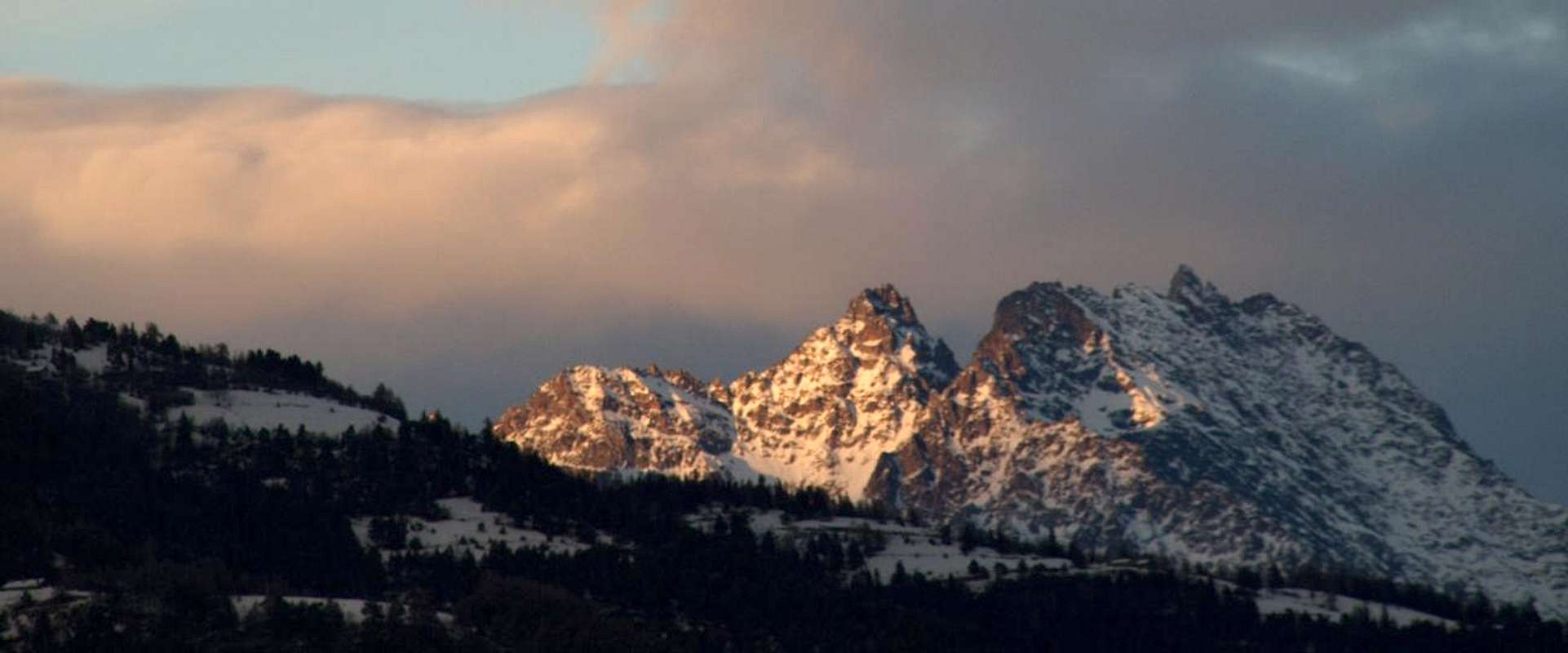
C) - Approach by Main Road n°27 of Gran San Bernardo near the alternative towards Echevennoz Hamlet or from Etroubles Common even with Snowshoes:
8) - from Echevennoz Fraction, immediately after Gignod and always on Great St. Bernard State Road, (1.233-1.264m; "Ei qui ven à nos" or is water that is in us, by the course of the stream that comes from above Arsy Vallon; "Hostel Marietty"), reached by a short detour from the Main Road, and starting from Dessus via a short private road, or more to the right (West) with the path n° 4 to arrive at a small village (1.408m, up to here with the private road which, passing high above Echevennoz from Northwest to Southeast, connects the Villages above Lavanche (around 1.300 meters) to this Gariache (1.472m)). From this, with the path to the South and through the forest to reach Eteley (1.716m), and the next route that comes from Etroubles, this via, in our opinion, certainly is the most recommended among the three described as more practical and the most direct (E/F; 2h'00/2h'15). Then continuue through path n° 4/5 (see below; E/F: 1h'00/1h'15 arriving on the pass.
9) - : from Etroubles Commune (1.270m) via the path n° 5A/5 concomitant with the private dirt road until the junction about 1.400 meters immediately after the village neighbor Alp Lavanche and before Champ-Reclos (1.425m); left on the left (Southeast) a secondary deviation, it continues in the opposite direction on the main road to gradually reach the Pastures of Yettes (1.591m), and through the Bois (Wood) de Peson and discarding the right to further branching Teppes Damon Pastures (1.879m), those following of Eteley. Continuing towards the vallon floor and crossing the Torrent d'Ars, you reach a junction immediately before the Alp Praz-Gallet (1.626m), which is to the left; this finally with a long diagonal to the South-southeast into forest to reach the Ars or Arsy Alpage, whence the preceding route (E/F; 2h'15/2h'30). From Ars Torrent, leaving right (West) the alpage continue to the South-southeast and with path reach the Passo Tardiva (E/F; 3h'00/3h'30).
10a/10b) - Finally, always departing Etroubles but seems slightly more to the West, climb directly with path unnumbered with larger circle to the West through the beautiful forest above first reaching the Pasture of Plan Pessey (1.703m) and then the junction just before Teppes Dèsott (1.938m). From this continue with two possibilities:
10 a) - from Teppes Dèsott reaching Eastward to the nearby Teppes Damon (1.979m) Alpages on the private dirt road from the opposite side, ie from Condemine-Petit Buthier-Mendey Praz-Gallet Villages and Pastures and concomitant with the path 3C; by the latter and to the Southeast almost reaching that of Eteley (1.716m) at the Torrent of Ars. Abandoning East the pastures continue to be marked by the South coming up with the trail 5/5A to a small secondary tributary arribing from the Cote Labiez; from this to continue through a small track to Alpe Ars or Arsy (1.975m), whence the Pass Tardiva as in previous routes (EE/F; 1h'15/1h'30 from Teppes Alpages; 3h'45/4h'15 total from Etroubles).
10 b) - the second is to continue to Teppes Dèsott for a short distance with branching to the South of the farm road until below the Grande Tete; before it ends, take a path not numbered towards East to the point 2.227 meters turned decidedly South reaching an unnamed alp isolated and then the next Arsy (EE/F; in less than half an hour).
Conclusive Footnote: all these finals trips require a good knowledge of the area and can be addressed in snowshoes if the same it is not too high. In addition it can also start from the adjacent Municipaliity of St. Oyen (1.377m), now fully in the Valley of Gran San Bernardo, via a short private road beyond Rio Artanavaz and at "Campings Pineta and del Mulino or of the Mill" and along the "Percorso Vita or Life Trail" in the Bois de Gorrey. By the same, through the trail n° 6A in the Bois de Lanche you reach the points 2.056, 2.358 meters at the base of the Northern Slope of the Great Tete (2.455m); immediately flanking the East the same you reach a junction leading to the East-southeast at fork of farm dirt road from Teppes Dèsott whence with the previous route to Arsy (EE/F+; 3/4h'00 from St. Oyen to Tardiva Pass).
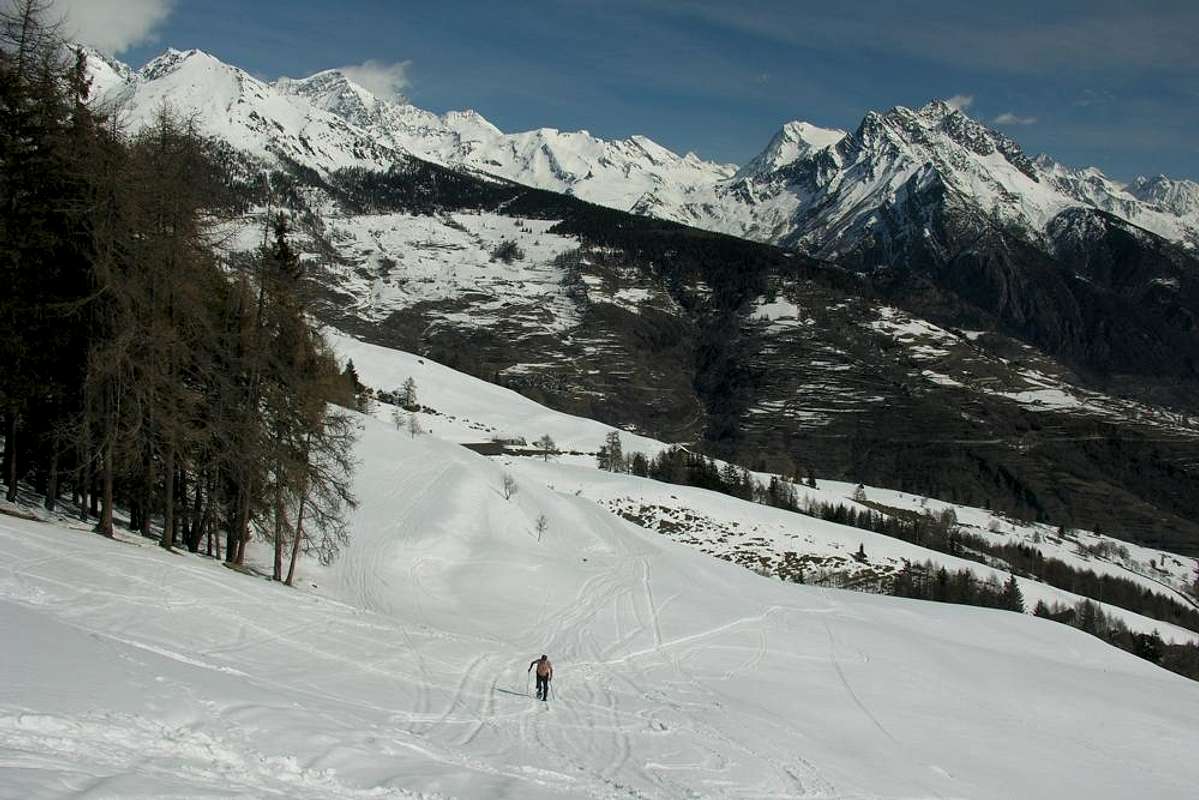
Traversata delle Punte di Metz e Chaligne, Colle e Cresta Tardiva (2.553 m, 2.608 m, 2.410 m, 2.418 m, 2.394 m)
1) - Valloncello di Arpilles e Comba Labe tramite il Col de Met e la Cresta Nord:
2) - Valloncelli di Clou-Met(z)-Chaligne sempre dal Col de Met e lungo la Cresta nord: dal Villaggio di Nuova Touraz (1.593/1.652 m; Ranch dei cavalli; segnale di divieto ai mezzi immediatamente dopo) in direzione Est-nordest tramite la privata poderale concomitante al sentiero n° 6 alle Alpi Metz di Bionaz (1.731 m), Vignon (1.789m), Condemine de Metz (1.874 m) e Metz (2.261 m), nei pressi del Torrent Labe. Dall'Alpeggio sempre tramite il sentiero n° 6 verso il Col de Met, tra Chaligne e Pointe de Met, e via precedente.
3) - Da Thouraz Dessus per la via de "la Tsitra" e lungo la Cresta Sud: a)- sempre da Touraz Dessus (1.652 m) proseguire col sentiero n° 7B direttamente a Settentrione attraverso il Bois de Thouraz fino a raggiungere la località cosiddetta "la Tsitra" (2.176 m); da questa continuare con la Cresta Sud-sudovest che progressivamente conduce ad un percorso più aperto. Oltrepassando una zona con grandi paravalanghe in legno, in breve si raggiunge facilmente l'ometto in pietra della Cima.
a1) - con giro più largo dapprima ad Est con la poderale ed oltrepassando gli Alpeggi di Vignon, Condemine de Metz e Moulin (1.794 m, 1.876 m, 1.880 m) fino alla località detta "Berrio di Bat" (1.954 m) nel Bois de Ban e poi ad Ovest si raggiunge il tornante 2.140 metri, subito sotto "la Tsitra" ed in breve con traversatina verso Ovest alla Cresta Sud.
a2) - oppure dal tornante continuare verso Settentrione tramite la medesima, concomitante al sentiero n° 8C, arrivando alla Tsa de Met donde al Colle ed alla Pointe de Met.
Nota: questi due itinerari sono più consigliabili quando nella foresta esiste troppa neve ricoprendo il sentiero; conviene quindi un giro più largo ma anche più aperto ed individuabile nei punti di riferimento, nonché maggiormente esposto al sole che prima trasforma la medesima. Nel secondo però bisogna stare più attenti ai soprastanti pendii Orientali, nonché nella salita al colle. In ogni caso in presenza di neve alta bisogna stare assolutamente lontano dai medesimi, percorrendo esclusivamente le due creste, delle quali meglio la Sud. Da segnalare infatti l'avvento di incidenti mortali abbastanza recenti per valanga nei vicini pendii della Pointa Chaligne (soprattutto sul Versante Est-nordest).
Variante a) - da Moulin guadare verso Ovest il piccolo Torrent de Conclonaz e con sentierino non numerato e neppur segnalato raggiungere la quota 2.008 tra i due Bois de Thouraz e Montagnetta; da qui con il sentiero n° 7B alla Vetta.
Variante c) - Oppure partendo dal bivio 2.277 metri presso la Tsa di Chesère (vedi itinerario successivo) attraversare verso Sudest con il sentiero n° 8C raggiungendo sempre "la Tsitra".

B) - Avvicinamento dalla Statale n°27 del Gran San Bernardo presso il bivio per Condemine con diverse varianti e possibilità d'uso delle Racchette da neve:
4) - dal bivio sulla Strada Statale per il Villaggetto di Condemine verso i Villaggi soprastanti di Grand Buthier (1.302 m), Petit Buthier (1.439 m) e gli Alpeggi di Roncailles, Rombason e bivio 1.854 metri tramite il sentiero n° 3A/2A od il concomitante con la poderale sempre n° 3A/2A con susseguente e relativa traversata dal bivio 2.105 metri Nord/Sud sullo spartiacque della Costa Tardiva (2.418 m, 2.394 m) insino al Passo Tardiva (2.410 m) con sentiero n° 3 (E/F; 3h'00/3h'15).
5) - Dal Rifugio Chaligne (1.936 m; costruzione degli anni 2000) al Passo Tardiva tramite sentierino non numerato a Nordovest sul Versante Sudest (E/F; 0h'45/1h'00).
6) - Inoltre dal rifugio, con sentierino n° 2 a Sud dapprima dentro la foresta, verso la selletta (2.405 m) sulla Cresta Est della Chaligne e corta facile traversata con discesina all'Alpe di Met (2.261 m; E/F; 1h'00/1h'15), dentro il Vallone Meridionale al di sotto il Versante Orientale del Colle e Punta di Met (2.485 m, 2.553 m) con salita ad entrambi.
7 - Ed ancora e sempre dal rifugio alla selletta 2.342 metri ed alla Punta Chaligne tramite la parte finale della Cresta Est (E/F+; più o meno stesse difficoltà e tempo).
Nota Importante: in inverno devon esser evitate sia la salita che la discesa soprattutto attraverso il Versante Nordest; sullo stesso si sono già verificate varie disgrazie mortali per valanga durante l'escursioni di Sci-Alpinismo. Sempre nella medesima stagione pur la Cresta Nord, inviante una ramificazione verso il Passo Tardiva ed un'altra verso la Cima de La Tsa (2.742 m), risulta alquanto pericolosa; in siffatte condizioni meglio il primo degli itinerari che si svolge all'interno della foresta, risulta certamente più sicuro e protetto. In caso contrario, é meglio e consigliabile scavalcare la selletta, perdendo un po'di quota, e risalire sull'opposto versante tramite il Col de Met (2.608 m; E/F; 1h'45/2h'15).
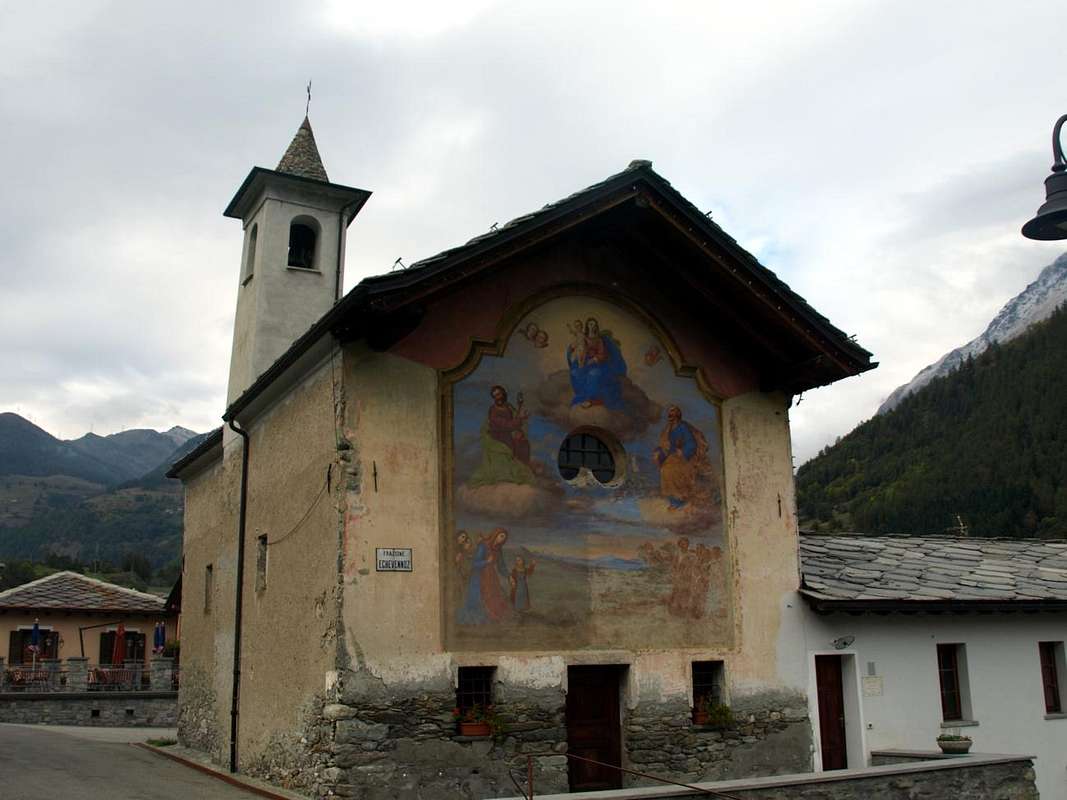
C) - Avvicinamento dalla Statale n°27 del Gran San Bernardo presso il bivio per la Frazione Echevennoz o dal Comune di Etroubles anche tramite Racchette:
8) - dalla Frazione di Echevennoz (1.233-1.264 m; "Ei qui ven à nos" cioé acque che vengono a noi, dal corso del soprastante torrente proveniente dal Vallone dell'Ars; "Ostello Marietty"), raggiungibile con breve deviazione dalla Strada Statale, e partendo dal settore superiore, cosiddetto Dessus, tramite una breve strada poderale, oppure leggermente più a destra (Ovest) per mezzo del sentiero n° 4, arrivare ad un villaggetto (1.408 m; si può giungere fino a qui anche con la poderale che, transitando alta da Nordovest verso Sudest sopra Echevennoz, connette i Villaggi presso Lavanche (all'incirca 1.300 metri) a quello di Gariache (1.472 m). Da questo, con sentiero verso Meridione ed attraverso la foresta, raggiungere il Villaggio d'Eteley (1.716 m), nonché la successiva via che proviene dal viciniore Etroubles; quest'itinerario, a nostro avviso, risulta certamente il più consigliabile tra i tre descritti, poiché via più pratica nonché maggiormente diretta (E/F; 2h'00/2h'15). Quindi continuare tramite sentiero n° 4/5 (vedi sotto; E/F: 1h'00/1h'15 raggiungendo il colle.
9) - dal Comune di Etroubles (1.270 m), tramite il sentiero n° 5A/5 concomitante con la strada poderale fino al bivio 1.400 metri circa subito dopo l'Alpe Lavanche e prima di Champ-Reclos (1.425 m); lasciata sulla sinistra (Sudest) una deviazione secondaria, si continua invece in direzione opposta sulla strada principale raggiungendo progressivamente gli Alpeggi di Yettes (1.591 m), ed attraversando il Bois de Peson e scartando a destra un'ulteriore ramificazione verso Teppes (1.879 m), quello a seguire di Eteley. Proseguendo verso il fondovalle ed attraversando il Torrent d'Ars, si raggiunge un bivio immediatamente prima dell'Alpe Praz-Gallet (1.626 m), che si lascia sulla sinistra; da questo infine con un lungo diagonale a Sud-sudest nel bosco si raggiunge la passerella appena prima dell'Alpe di Ars, donde alla precedente via (E/F; 2h'15/2h'30). Dal Torrente di Ars, lasciando a destra (Ovest) l'alpeggio continuare verso Sud-sudest e con sentiero raggiungere il Passo Tardiva (E/F; 3h'00/3h'30).
10a/10b) - infine, con partenza sempra da Etroubles appena più ad Ovest, salire direttamente con sentiero non numerato attraverso la bella foresta con giro più accentuato ad Occidente raggiungendo dapprima Plan Pessey (1.703 m) e poi il bivio appena precedente l'Alpe Teppes Dèsott (1.938 m). Da questo proseguire con due possibilità:
10a) - da Dèsott raggiungere verso Oriente quella viciniora di Damon (1.979 m) sulla poderale proveniente dal versante opposto, ovvero da Condemine-Petit Buthier-Mendey-Praz Gallet e concomitante al sentiero n° 3C; da quest'ultima e verso Sudest quasi raggiungere quella d'Eteley (1.716 m) presso il Torrent d'Ars. Lasciato ad Est quest'alpeggio continuare invece decisamente a Mezzogiorno arrivando col sentiero n° 5/5A ad un immissario secondario proveniente dalla Cote Labiez; da questo continuare tramite una piccola traccia sino all'Alpe Ars (1.975 m), donde al Passo come nei precedenti itinerari (EE/F; 1h'15/1h'30 da Teppes; 3h'45/4h'15 in totale da Etroubles).
10b) - consiste nel proseguire da Dèsott per breve tratto con la ramificazione a Sud della poderale fin sotto alla Grande Tete; prima che termini, prendere ad Est un sentierino non numerato che al punto 2.227 metri volge decisamente a Sud raggiungendo un'alpe innominata ed isolata e quindi la successiva d'Ars (EE/F; circa mezz'ora in meno).
Nota Conclusiva: tutte queste gite finali richiedono una buona conoscenza del territorio e possono essere affrontate in racchette da neve se la stessa non é troppo alta. Inoltre si può partire anche dallo adiacente Comune di St. Oyen (1.377 m), ormai completamente nella Valle del Gran San Bernardo, tramite breve poderale oltre il Rio Artanavaz e presso i "Campings Pineta e del Mulino" e lungo il "Percorso Vita" nel Bois de Gorrey. Dallo stesso, tramite il sentiero n° 6A nel Bois de Lanche si raggiungono i punti 2.056, 2.358 metri alla base del Versante Settentrionale della Grande Tete (2.455 m); fiancheggiando subito ad Oriente la medesima si raggiunge un bivio che porta verso Est-sudest alla biifocazione della poderale da Teppes Dèsott donde con il precedente itinerario ad Arsy (EE/F+; 3/4h'00 da St. Oyen al Passo Tardiva).
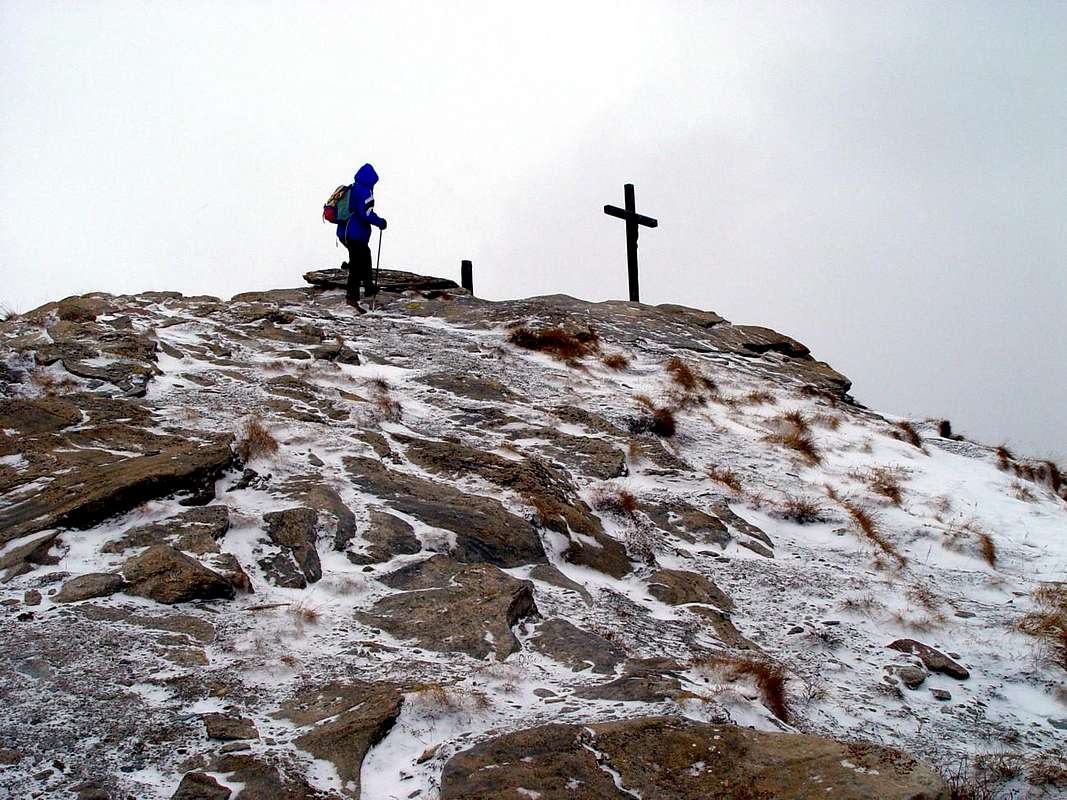
Difficulty & Equipment
DifficultyThis route can be considered E or EE/BSA (Experts Hikers or Good Skiers-Montaineers) in winter by Ski-Mountaineering or Snowshoeing.
L'itinerario è classificato E oppure EE/BSA (Buoni Sciatori Alpinisti) in inverno tramite Sci-Alpinismo od in Racchette da neve.

Equipment
Hiking gear or in winter with ski and snowshoes (better with ARVA).
Da Escursionismo oppure in inverno tramite Sci oppure in Racchette da neve (meglio con ARVA).
Mountain Conditions
- Meteo: you can find all the needed informations at the official site of the Valle d'Aosta Region:
- Valle d'Aosta Meteo
Books and maps
- "Guida dei Monti d'Italia-Alpi Pennine" (Vol. I°) di Gino Buscaini-Club Alpino Italiano/Turing Club Italiano, Luglio 1971.
- Kompass "Monte Bianco Valle d'Aosta Sentieri e Rifugi" Carta turistica 1:50.000.
- Kompass "Gran Paradiso Valle d'Aosta Sentieri e Rifugi" Carta Turistica 1:50.000.
- I.G.C. Istituto Geografico Centrale Torino "Massiccio del Monte Bianco" (n° 4), Torino, 1998 1:50.000.
- Studio F.M.B. "Monte Bianco-Mont Blanc", Bologna 1988 1:50.000.
- I.G.C. Istituto Geografico Centrale "Carta dei sentieri e dei rifugi" 1:25.000.
- I.G.M. Istituto Geografico Militare 1:25.000.
Important Information
- REGIONE AUTONOMA VALLE D'AOSTA the official site.
- FONDAZIONE MONTAGNA SICURA Villa Cameron, località Villard de la Palud n° 1 Courmayeur (AO) Tel: 39 0165 897602 - Fax: 39 0165 897647.
- A.I.NE.VA. (Associazione Interregionale Neve e Valanghe).
Useful numbers
- Protezione Civile Valdostana località Aeroporto n° 7/A Saint Christophe (Ao) Tel. 0165-238222.
- Bollettino Meteo (weather info) Tel. 0165-44113.
- Unità Operativa di Soccorso Sanitario Tel. 118.



